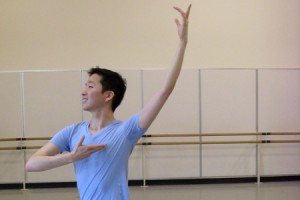
by Lucy Vurusic-Riner
I’ve been avoiding the teacher perspective on body image post for a long time. It’s that subject that lurks in the shadows and I’m too close to want to address it. However, in the aftermath of last month’s Wisconsin news anchor debacle, where a woman just doing her job (well, I might add) was criticized for her weight (which in no way impacts her ability to report the news, I might add again). I feel that it’s time to broach the topic.
The fact is, body image plays a huge role in my day to day. In fact, to say I don’t think about it every single day as a high school dance teacher would be a flat out lie. Over the last 18 years I have thought about body image at least once a day, EVERY day, as I enter one of my classes. The issues have varied depending on the school and community surrounding it. The frequency of how many girls are noticeably affected by it differs as well. But it’s always safe to assume that there is someone in the room with me looking at their body in a distorted way; maybe even me.
Personally, I have been lucky with the gene pool bestowed upon me. Because quite frankly, I think that’s where you have to look first. We are as short or tall as we are because of how the chromosomes matched up. My long torso was not something I had to do massive amounts of bar hangs to achieve. I have it because I have my grandmother’s body, and alas, she too had a long torso.
Likewise, I have some pretty crappy feet and bad turnout as far as the dance world is concerned. My genetics could have told me that I had horrible arches as early as 7 or 8, when I tried shoving my feet into pointe shoes. I bought the do-hickey that stretches your arches and I laid on my belly in frog position to open my hips for hours at a time. To a certain degree maybe that torture, as well as determination in class and a strong work ethic, did make me a better dancer, but guess what? My feet and turn out are still nothing to write home about. But truly, amidst all of this, to the common person’s naked eye, I have always had a body “suitable’ for dancing. Phew.
So how do I approach this in my dance classes? My tactic for the most part has been to diffuse it at every turn. In my first years of teaching I had some pretty severe cases. Girls that wanted so badly to be in the highest level classes and have the most performance experience. Girls who wanted to please their parents (who often consciously put pressure on their daughters), girls who needed to live up to their friends and acquaintances ideas of what being a dancer meant. And a lot of the time, I couldn’t even blame them. So much of what being a dancer means to the general public is solely based on cheesy movies and fantasy. How many of you have ever told someone you were a dancer and then had to tolerate some stupid comment about stripping or lap dances? I found that “controlling” one’s eating was the one place that my students could feel they were empowered to do something about the way that others perceived them. They might not be able to physically alter their flat feet or poor turnout–but they sure as hell could get skinny.
With a few more years of teaching under my belt, I started to notice that poor body image was becoming less of an issue with my students. Sure, I still had the occasional one or two that popped up every three or four years; the ones that need to be hospitalized or get counseling. But it soon became an issue that was manageable.
What had happened? Had body image problems become a thing of the past? Hardly. I sat down with a group of my dancers a few years back and we had a long discussion that, at first, was simply a conversation about nutrition and diet and what people like to eat, but then turned into a riveting discussion on exercise and how to most efficiently take care of our bodies.
What I learned was that part of the reason I wasn’t seeing that problem was because we had formed a safe dance community within our classroom.
I rarely talked about weight. I never degraded my body or how I looked in front of my students (in fact, they often had to listen to me talk about how I embraced by big butt). And I ate what I wanted to eat, when I wanted to eat it, in front of them and with no guilt, because feeling shameful, about anything, has never helped someone overcome any sort of obstacle.
I want my students to be appreciative of their bodies and how to live in them. Adolescent girls have enough to worry about with their changing bodies, raging hormones and the pressure of becoming young, responsible adults.
I believe teaching dancers how to take care of themselves and respect their bodies needs to become an intuitive practice; one that we take part in each day when we talk about foods that we love, clothes that we feel comfortable in and dance classes that we take that make us feel good about ourselves. Some dance teachers might read this and say that I’m not being a very honest teacher or mentor if I don’t talk to my girls about their weight. Guess what? It’s not going to happen.
Why? Because my dancers already know if they need to lose a few pounds. They knew before I did; they stared at themselves in the mirror long before I did, and they will continue to find things about themselves that aren’t good enough–just like I did. Yes, I want them to be healthy and make smart nutritional choices, and when it’s appropriate I talk to ALL my dancers about this as a group. Because–let’s be honest again…
Some of those skinny girls need to hear about how to take care of their bodies far more than the bigger girls. In the end, all that matters to me is that they love the body they are in.

Contributor Lucy Vurusic-Riner is a native Chicagoan who has been supporting and contributing to the dance community for over twenty years. She received her Bachelor of Science Degree in Dance Performance and Dance Education from Illinois State University. Lucy has been a member of Molly Shanahan/Mad Shak, RTG Dance Company and Matthew Hollis’ “The Power of Cheer.” She has also had the opportunity to be part of the community casts of White Oak Dance Project and David Dorfman Dance.
Lucy has taught modern, hip hop, and jazz at numerous studios and high schools in the Chicagoland area. She was the Director of Dance at Oak Park and River Forest High School from 1999 to 2012. In 2005, Lucy completed her Masters Degree in Education from National Louis University and also received the Midwest Dance Teacher of the Year award and was the youngest of four finalists in the running for the National Dance Teacher of the Year award. Lucy and artistic partner, Michael Estanich, formed RE|Dance Group in 2010. RE|Dance Group investigates humanity in movement through long distance collaboration.
In 2012, Lucy joined the dance faculty at New Trier High School in Winnetka, IL. When she is not immersed in dance, she is at home with her two great kids, Margie and Luka, and her very supportive husband, Jim.







